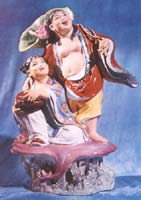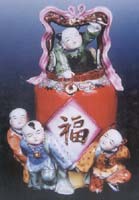|
Ceramic Culture and Philosophy
As a form of arts and crafts, ceramics depends on and reflects the Chinese philosophy and aesthetic thinking of the people.
 We Chinese people attach much importance to moral and spiritual integrity-"an army corps can be deprived of its commander-in-chief while ordinary people can never be deprived of moral integrity", "pines and cypresses would never wither in severely cold winter", "the three just and righteous friends in winter" referring to pine, bamboo and plum blossom. This is excellently expressed in ceramic art, in which such patriots and moral people as Qu Yuan, Su Wu, Guan Yu, Li Bai, Du Fu, Badashanren, Zheng Banqiao, and so on are vividly depicted. Even Zhong Kui the grand ghost is personalized as a valiant and firm, kind and helpful hero who is obviously worldlier. Pine, bamboo, plum blossoms, lotus, orchid, chrysanthemum and their like are often the themes of ceramic art not only because of their imagoes, but more importantly of the artists' pursuing for moral integrity that they symbolize. Being oftentimes used in ceramic art, chrysanthemum is unyieldingly blooming in cold weather, which symbolizes the noble and pure personality and shows the scene of "not the spring scenery, but the most beautiful spring scenery". We Chinese people attach much importance to moral and spiritual integrity-"an army corps can be deprived of its commander-in-chief while ordinary people can never be deprived of moral integrity", "pines and cypresses would never wither in severely cold winter", "the three just and righteous friends in winter" referring to pine, bamboo and plum blossom. This is excellently expressed in ceramic art, in which such patriots and moral people as Qu Yuan, Su Wu, Guan Yu, Li Bai, Du Fu, Badashanren, Zheng Banqiao, and so on are vividly depicted. Even Zhong Kui the grand ghost is personalized as a valiant and firm, kind and helpful hero who is obviously worldlier. Pine, bamboo, plum blossoms, lotus, orchid, chrysanthemum and their like are often the themes of ceramic art not only because of their imagoes, but more importantly of the artists' pursuing for moral integrity that they symbolize. Being oftentimes used in ceramic art, chrysanthemum is unyieldingly blooming in cold weather, which symbolizes the noble and pure personality and shows the scene of "not the spring scenery, but the most beautiful spring scenery".
The valuable idea of "harmony between people" exists in the Chinese culture. Starting from Confucius, "kindheartedness", the core of which is "loving people", has been advocated. There should be more love and less fight. Unity is the source of power. The idea of "respecting people" weighs a lot in Chinese philosophy. People have been juxtaposed with the heaven and the earth, and together with them been called "The Three Talents". This idea was first expressed in the textual records from the Shang dynasty. "The Vow of the Qin" in "The Book of Documents" ("Shangshu Qinshi") recorded "The heaven and the earth are the parents of nature, and people the spirit of nature." Xunzi stated it more clearly in the chapter of "The King's Management of His Kingdom" from "Xunzi", "Water and fire have no life but 'qi', grass and wood have no senses but life, birds and beasts have no moral integrity but senses, while people have qi, life, senses and more integrity, and therefore are the most dignified in the world." This idea has deeply influenced the production of all forms of art in China, of course including ceramic art, which shows the idea of "man is the key", and "to take advantage of objects to serve people". The "Luao" chapter from "The Book of Documents" reads "unconfined to the senses, you will always see the truth of the objects, however, if attached to material substances, you will lose your moral integrity." Similar ideas exist in Taoism, for instance, "never let material substances subdue your moral integrity", "never let material substances harm yourself", "keeping detached from material substances, we will control them."
 The ideas of "harmony between people" and "man is the key" have been vividly expressed in ceramic art long since. Regarding the relationships between man and nature, by exploring new materials and techniques, they sing high to the consciousness of the principal role of man in such works as "the two harmonious immortals", "reconciliation of the marshal Lian Po and the prime minister Lin Xiangru", "the God of Happiness". All the figures are delighted and cheerful-the big-belly arhat, the arhat with five children; Avalokitesvaras are always messianic; and none of the eight immortals is upset, instead the works of them are full of happiness, auspiciousness and detachment. Though of religious themes, they reflect the ideology of the Chinese people. Many ceramic art works are about auspiciousness -the three stars of happiness, fortune and longevity, phoenix which is the king of birds and symbolizes big fortune and auspiciousness, crane which symbolizes longevity and moral integrity, bamboo which has the same pronunciation with "blessing" and therefore embodies happiness during a person's life time, "li yu" carp-"li" and "yu" are similarly pronounced to "rites" and "wealth" and therefore symbolizes promotion and wealth, and so on. Being the most dignified life, man should search for happiness, harmony and well-being; master and make use of the material world; be enterprising to find, produce, and enjoy beauty. Meanwhile he should keep self-worth and moral integrity at both national and personal levels. All these themes are fully expressed in the ceramic works. The ideas of "harmony between people" and "man is the key" have been vividly expressed in ceramic art long since. Regarding the relationships between man and nature, by exploring new materials and techniques, they sing high to the consciousness of the principal role of man in such works as "the two harmonious immortals", "reconciliation of the marshal Lian Po and the prime minister Lin Xiangru", "the God of Happiness". All the figures are delighted and cheerful-the big-belly arhat, the arhat with five children; Avalokitesvaras are always messianic; and none of the eight immortals is upset, instead the works of them are full of happiness, auspiciousness and detachment. Though of religious themes, they reflect the ideology of the Chinese people. Many ceramic art works are about auspiciousness -the three stars of happiness, fortune and longevity, phoenix which is the king of birds and symbolizes big fortune and auspiciousness, crane which symbolizes longevity and moral integrity, bamboo which has the same pronunciation with "blessing" and therefore embodies happiness during a person's life time, "li yu" carp-"li" and "yu" are similarly pronounced to "rites" and "wealth" and therefore symbolizes promotion and wealth, and so on. Being the most dignified life, man should search for happiness, harmony and well-being; master and make use of the material world; be enterprising to find, produce, and enjoy beauty. Meanwhile he should keep self-worth and moral integrity at both national and personal levels. All these themes are fully expressed in the ceramic works.
 Important in Chinese philosophy are the idea of form and spirit and the idea of passion and desire. People hold idealistic or materialistic views of them. The materialistic ones are clearly, assuredly and spontaneously persisted in the ceramic art from Jingdezhen. Xunzi, a materialistic thinker from the warring states period, argued "spirit derives from its material carriers". Then Fan Shen from the Han dynasty in his "On Extinguishments of Spirit" inherited Xunzi's view, "spirit is material, and vise versa, therefore the spirit will exist if its material form exists and the spirit will vanish if its material form vanishes." And they have many successors in various periods. Important in Chinese philosophy are the idea of form and spirit and the idea of passion and desire. People hold idealistic or materialistic views of them. The materialistic ones are clearly, assuredly and spontaneously persisted in the ceramic art from Jingdezhen. Xunzi, a materialistic thinker from the warring states period, argued "spirit derives from its material carriers". Then Fan Shen from the Han dynasty in his "On Extinguishments of Spirit" inherited Xunzi's view, "spirit is material, and vise versa, therefore the spirit will exist if its material form exists and the spirit will vanish if its material form vanishes." And they have many successors in various periods.
I cannot make a farfetched conclusion that the ceramic artists consciously accept the materialistic view, let alone there is a very important principle in the theory of art, that is, "expressing spirit through its material form", "having both the spirit and its material form". The relationships between the philosophical and artistic conceptions of the consonance of form and its spirit is not the most concerned topic here, however, when building up artistic figures in ceramic art, the artists stick to the very tradition.
Of whatever topics or using whatever techniques, every work is realistic and vivid which shows the principle of the spirit consonance with its object.
 Many theories on "passion and desire" co-exist in ancient Chinese philosophy. The existence of passion and desire can never be denied in the "non-desire theory", the "scanty-desire theory" or the "abstinence theory". In fact, ancient Chinese thinkers posed many penetrating arguments. According to "On Heaven" from the "Xunzi", passion has seven forms-joy, anger, worry, misgivings, sadness, fear and shock. Besides this rather stereotyped theory, there are the arguments of "seven forms of passion" and "four forms of passion", and so on. According to "desire is produced when physicality, interest, power and success cannot be attained" (See "On Reading the Completed Edition of the Four Classics", vol. 6), accordingly Wang Fuzhi from the Qing dynasty divided the desires of man into four categories. Despite different categorizations, nobody can deny its existence. Many theories on "passion and desire" co-exist in ancient Chinese philosophy. The existence of passion and desire can never be denied in the "non-desire theory", the "scanty-desire theory" or the "abstinence theory". In fact, ancient Chinese thinkers posed many penetrating arguments. According to "On Heaven" from the "Xunzi", passion has seven forms-joy, anger, worry, misgivings, sadness, fear and shock. Besides this rather stereotyped theory, there are the arguments of "seven forms of passion" and "four forms of passion", and so on. According to "desire is produced when physicality, interest, power and success cannot be attained" (See "On Reading the Completed Edition of the Four Classics", vol. 6), accordingly Wang Fuzhi from the Qing dynasty divided the desires of man into four categories. Despite different categorizations, nobody can deny its existence.
In regard to the issue of passion and desire, ceramic art inherits and reflects the ideology and psychology of the Chinese people, especially that of the populace. By using specific visual, touchable and appealing figures, these works directly express the "passion" and "desire", and reach their various aspects, which has spontaneously been the case for thousands of years.
This fully explains that the Chinese people have always been searching for and loving beautiful life.
However they have never been carnalistic or ascetic. What they have searched for is noble, healthy, auspicious, satisfactory and harmonious life which is reflected by the ceramic art works.
In addition, one point needs to be mentioned that the idea of flexibility has been shown in ceramic art in history and at present, which is the common trend shared by all the forms of the functional art in China. "Assessing the Work of Craftsmen" begins like this, "there are six professions in a nation, among which are artisans and craftsmen. Some (of them) are sitting and discussing the 'Dao', some are busy producing works, and some are judging the variability of the works to determine various materials and to classify various earthen models." In short, pragmatic arts should agree to different conditions to meet the diverse spiritual needs of the people at all levels.
Ceramic Culture and Literature
Ceramic Culture and Folk-custom
|

